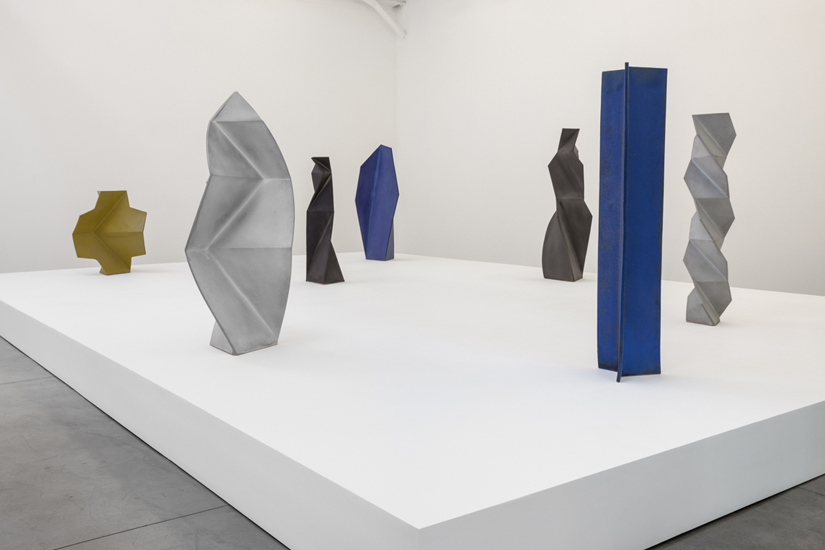John Mason’s Crosses, Figures, Spears, Torques (September 7 – October 26, 2013) at David Kordansky Gallery brought together a selection of masterworks from 1997 to 2002. Mason’s characteristic later forms were present in the seven tall, monochrome pieces. The show illustrates why Mason is celebrated for his revolutionary use of clay and confirms his place in the fine art cannon.
Mason is one of the essential Los Angeles-based artists of the postwar period. With his peers Peter Voulkos and Ken Price, who were also associated with what was then called The Otis Art Institute, Mason formed the vanguard of a new California ceramics movement. Together, they broke from the craft tradition and took ceramics to the forefront of contemporary art. Mason had his first solo show at the legendary Ferus Gallery, whose stable of artists was a veritable who’s who of contemporary art. Mason’s major works from this time, the free-standing “Spear” and “X” forms and Blue Wall (1959), which was recently featured in Pacific Standard Time at the Getty Center, were monumental, which was completely unprecedented in ceramic-based art.
Mason has explored the forms of “Crosses” and “Spears” throughout his career. Early on they took the form of expressive, totemic sculptures that incorporated wheel-thrown forms. The works on view in this exhibition––constructed from slabs–-draw attention to the precision and complexity of their geometry, as well as the warmth and depth of their glazes. As the viewer moves around each object, its planes reveal surprising intersections and angles and complex plays of light and shadow, so that a single form reads as many forms. For all of the sculpture’s intellectual precision and masterful construction, the sculptures are resolutely physical objects that must be encountered to be fully appreciated.
In his review of the show in the Los Angles Times (September 13, 2013), Christopher Knight points out that slab construction of clay is about as ancient an artistic medium as there is. He states:
John Mason has been employing it [slab construction] for 50 years…. Despite its antiquity, these totemic clay slabs suggest emphatically modern machine forms. Screws, drills, blades and the like are evoked through Minimalist geometry and Cubist intersection of planar shapes.
This being clay fired in a kiln, however, natural process cannot be denied. Planes of clay bend slightly from their own weight, while a surface skin of applied glaze contrasts with the supporting skeletal structure. The result is sculpture that is often inescapably figurative, even without precise description of a human body.
Mason’s “figures”, stacked arrangements of modular units, combine the geometrical rigor that typifies his work with the expressive, sensuous plasticity unique to clay. Knight goes on to praise Charcoal Figure (2002), a stack of torqued planes that diminish as they rise. He likens different views of the sculpture to the form of a classical Venus, the silhouette of a bottle, Peter Voulkos work from 1960’s, and “the swelling, sonorous shape of a musical instrument by Picasso”. He concludes with, “Mason’s best sculptures pile art atop history atop autobiography. They’re a delight to behold. ”
John Mason has been the subject of solo exhibitions at numerous institutions, including the San Francisco Museum of Modern Art; the Los Angeles County Museum of Art; the Corcoran Gallery of Art, Washington, D.C.; the Minneapolis Institute of Art; Minnesota; and the Pasadena Museum of Art, California. Group exhibitions include Pacific Standard Time: Crosscurrents in L.A. Painting and Sculpture, Getty Center, Los Angeles; Clay’s Tectonic Shift: John Mason, Ken Price, Peter Voulkos, Ruth Chandler Williamson Gallery, Scripps College, Claremont, CA; Color and Fire: Defining Moments in Studio Ceramics, 1950-2000, Los Angeles County Museum of Art; Current Trends in Ceramics, Aichi Prefectural Museum, Asahi Shimbum, Japan; The 20th Century: San Francisco Museum of Modern Art Collection, San Francisco Museum of Modern Art; 200 Years of American Sculpture, Whitney Museum of American Art, New York; 1973 Biennial Exhibition: Contemporary American Art, Whitney Museum of American Art, New York; and Contemporary Ceramic Art – Canada, USA, Mexico and Japan, The National Museum of Modern Art, Tokyo, Japan. Mason’s work is included in the collections of many public institutions. These include the Art Institute of Chicago; the San Francisco Museum of Modern Art; the World Ceramic Center, Ichon, Korea; the Metropolitan Museum of Art, New York; the Museum of Fine Arts, Boston; the Los Angles County Museum of Art; the Renwick Gallery, National Museum of American Art, Smithsonian Institute, Washington, D.C.; and the Carnegie Museum of Art, Pittsburgh.
Bill Rodgers is a contributing editor to CFile.
 Installation views of John Mason’s Crosses, Figures, Spears, Torques at David Kordansky Gallery, Los Angeles (September 7- October 6, 2013)
Installation views of John Mason’s Crosses, Figures, Spears, Torques at David Kordansky Gallery, Los Angeles (September 7- October 6, 2013)
 John Mason, Folded Cross, Yellow-Gold, 2002. Ceramic, 39 x 31.5 x 24 inches (99.1 x 80 x 61 cm)
John Mason, Folded Cross, Yellow-Gold, 2002. Ceramic, 39 x 31.5 x 24 inches (99.1 x 80 x 61 cm)
 John Mason, Spear Form, Soft White, 1999. Ceramic, 66 x 28 x 28 inches (167.6 x 71.1 x 71.1 cm)
John Mason, Spear Form, Soft White, 1999. Ceramic, 66 x 28 x 28 inches (167.6 x 71.1 x 71.1 cm)
 John Mason, Charcoal Figure, 2002. Ceramic, 64 x 23.5 x 19.5 inches (162.6 x 59.7 x 49.5 cm)
John Mason, Charcoal Figure, 2002. Ceramic, 64 x 23.5 x 19.5 inches (162.6 x 59.7 x 49.5 cm)
 John Mason, Vertical Torque, White, 1997. Ceramic, 58.75 x 12 x 12 inches (149.2 x 30.5 x 30.5 cm)
John Mason, Vertical Torque, White, 1997. Ceramic, 58.75 x 12 x 12 inches (149.2 x 30.5 x 30.5 cm)
Watch our Video Program about John Mason on the Screen



I remember the work of Jan van der Vaart. My teacher at the Gerrit Rietveld Academy in Amsterdam.
He would recognize this style. Has a similarity with this work. Babs Haenen.